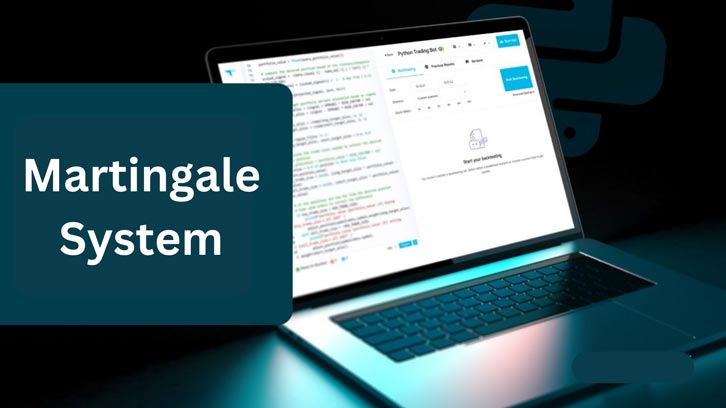The Martingale Strategy strategies started in 18th-century France, the most basic form is when a person wins the stake if a coin comes up heads and loses if it comes up tails. The system became popular in 1891 when a well-known person called Charles De Ville Wells, typically known as the Man who Broke the Bank at Monte Carlo, won over 1,000,000 francs playing roulette using the Martingale Strategy, in today's money this is about $13,000,000. He needed deep pockets and help from the banks to make it happen.

A Martingale Trading Strategy works much better in Forex trading because it lowers your average entry price.
The problem with this type of strategy is that you need a large supply of money to achieve 100% profitability. It's also important to understand that the amount you risk on a trade will be far higher than any potential gain, but there are also methods to improve the martingale strategy to increase the chances of winning.
Understanding the Martingale Strategy and its Limitations
The martingale strategy, rooted in the theory of mean reversion, is a popular approach in financial trading. While it offers potential benefits, it is essential to be aware of its limitations. This educational article explores the principles behind the martingale strategy, the risks involved, and strategies to enhance its effectiveness.
The Theory of Mean Reversion
The Martingale strategy is based on the concept of mean reversion, which suggests that asset prices tend to move back towards their average or equilibrium over time. Traders using this strategy assume that after a price deviation, the price will eventually revert to the mean, presenting an opportunity for profit.
Financial Considerations
Limited Capital: Achieve positive results with the martingale strategy, it requires a substantial capital base. Without an ample supply of funds, traders may face challenges in executing the strategy effectively.
Account Risk: It is crucial to acknowledge that the risk taken on each trade is often significantly higher than the potential gain. Traders must carefully assess and manage their risk exposure to safeguard their trading accounts.
Drawbacks and Challenges
Missed Trades: The martingale strategy involves enduring missed trades, where traders may need to wait for the right market conditions to materialize. It is essential to exercise patience and avoid impulsive actions that could harm the trading account.
Account Bankruptcy Risk: Due to the increased risk involved with each trade, a series of unsuccessful trades can deplete the trading account. Traders must be cautious and employ risk management techniques to mitigate the potential for significant losses.
Enhancing the Martingale Strategy
While the martingale strategy has inherent drawbacks, there are ways to improve its effectiveness:
Rigorous Analysis: Conduct thorough research and technical analysis to identify assets with strong mean reversion tendencies. This can increase the probability of successful trades and improve overall profitability.
Effective Risk Management: Implement robust risk management techniques, such as setting appropriate stop-loss levels and diversifying the portfolio, to protect against substantial losses.
Adjusting Trade Size: By carefully adjusting the trade size in proportion to the trading account's equity, traders can better manage the risk-reward ratio and minimize the potential for account depletion.
Incorporating Supporting Indicators: Utilize additional technical indicators or fundamental analysis to complement the martingale strategy. This can provide supplementary confirmation signals and increase the chances of successful trades.

Conclusion
The martingale strategy, relying on mean reversion, can be a risky approach if not executed properly. Traders must understand the challenges associated with limited capital, potential account bankruptcy, and the imbalanced risk-reward ratio. However, by conducting comprehensive analysis, implementing effective risk management, and utilizing supplementary indicators, traders can enhance the martingale strategy's potential for success while mitigating its inherent limitations.
Price Action
The system will only start trading in the direction of the trend where there are (x) consecutive bullish or bearish candles, this helps identify a solid trend direction, also the last candle that formed must be in the same direction and (x) pips in size.
Risk Management
There are many risk management features that include, a stop loss and take profit, an equity stop that will stop the robot and close trades when your equity drops below a certain value, and a maximum drawdown stop, so when the equity drawdown of your account drops a set percentage. Also, some additional features like a Friday stop so no trades run over the weekend.
Custom Parameters
The list of settings for this trading robot is shown below together with an explanation of the ones that are not obvious.
- Initial Quantity - this is the starting trade size in lots before it is increased in value.
- Lots Multiplier - the value that is multiplied by the initial quantity on each losing trade.
- Equity Stop - when you are losing below or equal to this value all orders are closed and the robot stops.
- Max Drawdown % - when you are losing (x) % of your equity all orders are closed and the robot stops.
- Number of Candles - the number of bullish or bearish candles to start trading in the same direction.
- Candle Size - the size in pips of the last candle.
- Minutes between trades - the number of minutes to wait before opening another trade.
- Cycle Period - the number of minutes to wait after each trade closes before opening another one.
- Cycle Reset -if set to NO, the Cycle period is disabled and the system will trade 24/7
Our Development Service
We provide professional & user-friendly development services to help traders build their automated trading robots or custom indicators, we can also help you by adding additional features to the Martingale Strategy or making any changes to the way it works, so you can use this project as a base-line to build a profitable trading robot.
Requirements
No specific requirements, this cBot should work with all versions of the cTrader Desktop platform.
How To Install & Remove
First, make sure you have the cTrader trading platform installed and then unzip the file and double-click on it to automatically install it onto the platform.
Any Questions?
If you have any questions, please first search our product help site for the answer, if you cannot find it, post a new question.



